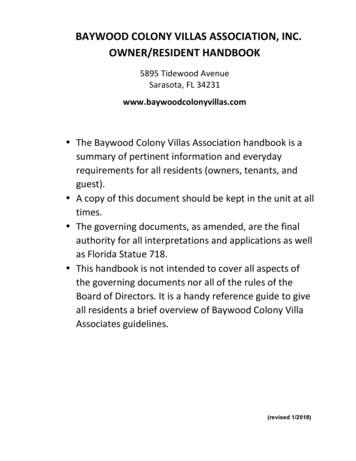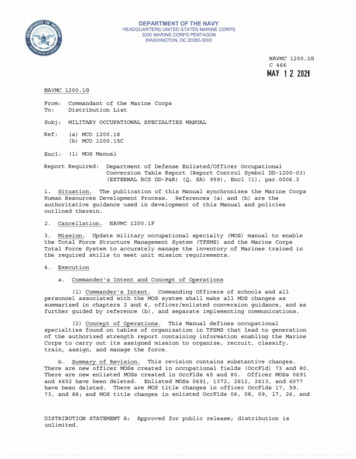
Transcription
HP-15COwner’s HandbookHP Part Number: 00015-90001Edition 2.4, Sep 2011
Legal NoticeThis manual and any examples contained herein are provided “as is”and are subject to change without notice. Hewlett-Packard Companymakes no warranty of any kind with regard to this manual, including,but not limited to, the implied warranties of merchantability noninfringement and fitness for a particular purpose. In this regard, HPshall not be liable for technical or editorial errors or omissionscontained in the manual.Hewlett-Packard Company shall not be liable for any errors orincidental or consequential damages in connection with the furnishing,performance, or use of this manual or the examples contained herein.Copyright 2011 Hewlett-Packard Development Company, LP.Reproduction, adaptation, or translation of this manual is prohibitedwithout prior written permission of Hewlett-Packard Company, exceptas allowed under the copyright laws.Hewlett-Packard CompanyPalo Alto, CA94304USA
IntroductionCongratulations! Whether you are new to HP calculators or an experienceduser, you will find the HP-15C a powerful and valuable calculating tool.The HP-15C provides: 448 bytes of program memory (one or two bytes per instruction) andsophisticated programming capability, including conditional andunconditional branching, subroutines, flags, and editing. Four advanced mathematics capabilities: complex number calculations,matrix calculations, solving for roots, and numerical integration. Direct and indirect storage in up to 67 registers.This handbook is written for you, regardless of your level of expertise.The beginning part covers all the basic functions of the HP-15C and how touse them. The second part covers programming and is broken down intothree subsections – The Mechanics, Examples, and Further Information – inorder to make it easy for users with varying backgrounds to find theinformation they need. The last part describes the four advancedmathematics capabilities.Before starting these sections, you may want to gain some operating andprogramming experience on the HP-15C by working through theintroductory material, The HP-15C: A Problem Solver, on page 12.The various appendices describe additional details of calculator operation,as well as warranty and service information. The Function Summary andIndex and the Programming Summary and Index at the back of this manualcan be used for quick reference to each function key and as a handy pagereference to more comprehensive information inside the manual.Also available from Hewlett-Packard is the HP-15C Advanced FunctionsHandbook, which provides applications and technical descriptions for theroot-solving, integration, complex number, and matrix functions.Note: You certainly do not need to read every part of the manualbefore delving into the HP-15C Advanced Functions if you arealready familiar with HP calculators. The use of and frequires a knowledge of HP-15C programming.3
ContentsThe HP-15C: A Problem Solver .A Quick Look at v .Manual Solutions .Programmed Solutions .12121314Part I: HP-15C Fundamentals .17Section 1: Getting Started .181818181919192021222222Power On and Off .Keyboard Operation .Primary and Alternate Functions .Prefix Keys .Changing Signs .Keying in Exponents .The "CLEAR" Keys .Display Clearing: and .Calculations .One-Number Functions .Two-Number Functions and v .Section 2: Numeric Functions .Pi .Number Alteration Functions .One-Number Functions .General Functions .Trigonometric Operations .Time and Angle Conversions .Degrees/Radians Conversions .Logarithmic Functions .Hyperbolic Functions .Two-Number Functions .The Power Function .Percentages .Polar and Rectangular Coordinate Conversions .2424242525262627282829292930Section 3: The Automatic Memory Stack, LAST X, andData Storage .324
Contents5The Automatic Memory Stack and Stack Manipulation .Stack Manipulation Functions .The LAST X Register and K .Calculator Functions and the Stack .Order of Entry and the v Key .Nested Calculations .Arithmetic Calculations With Constants .Storage Register Operations .Storing and Recalling Numbers .Clearing Data Storage Registers .Storage and Recall Arithmetic .Overflow and Underflow .Problems .32333536373839424243434545Section 4: Statistics Functions .47474849525353545557Probability Calculations .Random Number Generator .Accumulating Statistics .Correcting Accumulated Statistics .Mean .Standard Deviation .Linear Regression .Linear Estimation and Correlation Coefficient .Other Applications .Section 5: The Display and Continuous Memory .Display Control .Fixed Decimal Display .Scientific Notation Display .Engineering Notation Display .Mantissa Display .Round-Off Error .Special Displays .Annunciators .Digit Separators .Error Display .Overflow and Underflow .Low-Power Indication .Continuous Memory .Status .585858595960606060616161626262
6ContentsResetting Continuous Memory .63Part II: HP-15C Programming .65Section 6: Programming Basics .66666666686869707474747577787879798081The Mechanics .Creating a Program .Loading a Program .Intermediate Program Stops .Running a Program .How to Enter Data .Program Memory .Further Information .Program Instructions .Instruction Coding .Memory Configuration .Program Boundaries .Unexpected Program Stops .Abbreviated Key Sequences .User Mode .Polynomial Expressions and Horner's Method .Nonprogrammable Functions .Problems .Section 7: Program Editing .The Mechanics .Moving to a Line in Program Memory .Deleting Program Lines .Inserting Program Lines .Examples .Further Information .Single-Step Operations .Line Position .Insertions and Deletions .Initializing Calculator Status .Problems .Section 8: Program Branching and Controls .The Mechanics .Branching .Conditional Tests .82828283838385858687878790909091
Contents7Flags .Examples .Example: Branching and Looping .Example: Flags .Further Information .GoTo .Looping .Conditional Branching .Flags .The System Flags: Flags 8 and 9 .92939395979798989899Section 9: Subroutines .101101101102102105105105The Mechanics .GoTo Subroutine and Return .Subroutine Limits .Examples .Further Information .The Subroutine Return .Nested Subroutines .Section 10: The Index Register and Loop Control .The V and % Keys .Direct Versus Indirect Data Storage WithThe Index Register .Indirect Program Control With the Index Register .Program Loop Control .The Mechanics .Index Register Storage and Recall .Index Register Arithmetic .Exchanging the X-Register .Indirect Branching With V .Indirect Flag Control With V .Indirect Display Format Control With V .Loop Control with Counters: I and e .Examples .Examples: Register Operations .Example: Loop Control With s .Example: Display Format Control .Further Information .Index Register Contents 14115115
8ContentsI and e .Indirect Display Control .116116Part III: HP-15C Advanced Functions .119Section 11: Calculating With Complex Numbers 31132133133135137The Complex Stack and Complex Mode .Creating the Complex Stack .Deactivating Complex Mode .Complex Numbers and the Stack .Entering Complex Numbers .Stack Lift in Complex Mode .Manipulating the Real and Imaginary Stacks .Changing Signs .Clearing a Complex Number .Entering a Real Number .Entering a Pure Imaginary Number .Storing and Recalling Complex Numbers .Operations With Complex Numbers .One-Number Functions .Two-Number Functions .Stack Manipulation Functions .Conditional Tests .Complex Results from Real Numbers .Polar and Rectangular Coordinate Conversions .Problems .For Further Information .Section 12: Calculating With Matrices .Matrix Dimensions .Dimensioning a Matrix .Displaying Matrix Dimensions .Changing Matrix Dimensions .Storing and Recalling Matrix Elements .Storing and Recalling All Elements in Order .Checking and Changing Matrix Elements Individually .Storing a Number in All Elements of a Matrix .Matrix Operations .Matrix Descriptors .The Result Matrix .138140141142142143143145147147147148
ContentsCopying a Matrix .One-Matrix Operations .Scalar Operations .Arithmetic Operations .Matrix Multiplication .Solving the Equation AX B .Calculating the Residual .Using Matrices in LU Form .Calculations With Complex Matrices .Storing the Elements of a Complex Matrix .The Complex Transformations Between ZP and Z .Inverting a Complex Matrix .Multiplying Complex Matrices .Solving the Complex Equation AX B .Miscellaneous Operations Involving Matrices .Using a Matrix Element With Register Operations .Using Matrix Descriptors in the Index Register .Conditional Tests on Matrix Descriptors .Stack Operation for Matrix Calculations .Using Matrix Operations in a Program .Summary of Matrix Functions .For Further Information 73174174176177179Section 13: Finding the Roots of an Equation .180180186188192193193193Using .When No Root Is Found .Choosing Initial Estimates .Using in a Program .Restriction on the Use of .Memory Requirements .For Further Information .Section 14: Numerical Integration .Using f.Accuracy of f .Using f in a Program .Memory Requirements .For Further Information .1941942002032042049
10ContentsAppendix A: Error Conditions .205Appendix B: Stack Lift and the LAST X Register .209209209210210211212Digit Entry Termination .Stack Lift .Disabling Operations .Enabling Operations .Neutral Operations .LAST X Register .Appendix C: Memory Allocation .The Memory Space .Registers .Memory Status (W) .Memory Reallocation .The m % Function .Restrictions on Reallocation .Program Memory .Automatic Program Memory Reallocation .Two-Byte Program Instructions .Memory Requirements for the Advanced Functions .Appendix D: A Detailed Look at .How Works .Accuracy of the Root .Interpreting Results .Finding Several Roots .Limiting the Estimation Time .Counting Iterations .Specifying a Tolerance .For Advanced Information .Appendix E: A Detailed Look at f .How f Works .Accuracy, Uncertainty, and Calculation Time .Uncertainty and the Display Format .Conditions That Could Cause Incorrect Results .Conditions That Prolong Calculation Time .Obtaining the Current Approximation to an Integral .For Advanced Information 38239239239240240241245249254257258
ContentsAppendix F: Batteries .Low-Power Indication .Installing New Batteries .Verifying Proper Operation (Self-Tests) .Function Summary and Index .11259259259261Complex Functions .Conversions .Digit Entry .Display Control .Hyperbolic Functions .Index Register Control .Logarithmic and Exponential Functions .Mathematics .Matrix Functions .Number Alteration .Percentage .Prefix Keys .Probability .Stack Manipulation .Statistics .Storage .Trigonometry 67268Programming Summary and Index .269Subject Index .271
The HP-15C:A Problem SolverThe HP-15C Advanced Programmable Scientific Calculator is a powerfulproblem solver, convenient to carry and easy to hold. Its continuousmemory retains data and program instructions indefinitely until you chooseto reset it. Though sophisticated, it requires no prior programmingexperience or knowledge of programming languages to use it.The new HP-15C is a modern re-release of the original HP-15C introducedin 1982. While the battery life of the new version is now estimated to be 1year for normal use, the calculator is now at least 150 times faster than theoriginal. The low-power indicator gives you plenty of warning before thecalculator stops functioning.The HP-15C also conserves power by automatically shutting its display offif it is left inactive for a few minutes. But don't worry about losing data –any information contained in the HP-15C is saved by Continuous Memory.A Quick Look at vYour Hewlett-Packard calculator uses a unique operating logic, representedby the v key, that differs from the logic in most other calculators.You will find that using v makes nested and complicatedcalculations easier and faster to work out. Let's get acquainted with how thisworks.For example, let's look at the arithmetic functions. First we have to get thenumbers into the machine. Is your calculator on? If not, press . Is thedisplay cleared? To display all zeros, you can press that is, press , then .* To perform arithmetic, key in the first number, press vto separate the first number from the second, then key in the second numberand press , -, * or . The result appears immediately after youpress any numerical function key.*If you have not used an HP calculator before, you will notice that most keys have three labels. To use theprimary function – the one printed in white on top of the key – just press that key. For those printed in goldor blue, press the gold key or the blue key first.12
The HP-15C: A Problem Solver13The display format used in this handbook is 4 (the decimal point is―fixed‖ to show four decimal places) unless otherwise mentioned. If yourcalculator does not show four decimal places, you may want to press 4 to match the displays in the examples.Manual SolutionsRun through the following two-number calculations. It is not necessary toclear the calculator between problems. If you enter a digit incorrectly, press to undo the mistake, then key in the correct number.To Compute9-6 39 6 549 6 1.569 531,441Keystrokes9v69v6*9v6 9v6YDisplay3.000054.00001.5000531,441.0000Notice that in the four examples: Both numbers are in the calculator before you press the function key. v is used only to separate two numbers that are keyed in oneafter the other. Pressing a numeric function key, in this case - * or Y,executes the function immediately and displays the result.To see the close relationship between manual and programmed problemsolving, let's first calculate the solution to a problem manually, that is, fromthe keyboard. Then we'll use a program to calculate the solution to the sameproblem with different data.
14The HP-15C: A Problem SolverThe time an object takes to fall to the ground (ignoring air friction) is givenby the formulat 2h,gwhere t time in seconds,h height in meters,g the acceleration due to gravity,9.8 m/s2.Example: Compute the time taken by astone falling from the top of the EiffelTower (300.51 meters high) to the earth.Keystrokes300.51 v2*9.8 Display300.5100601.020061.32867.8313Enter h.Calculates 2h.(2h) /g.Falling time, seconds.Programmed SolutionsSuppose you wanted to calculate falling times from various heights. Theeasiest way is to write a program to cover all the constant parts of acalculation and provide for entry of variable data.Writing the Program. The program is similar to the keystroke sequenceyou used above. A label is useful to define the beginning of a program, anda return is useful to mark the end of a program. Also, the program mustaccommodate the entry of new data.Loading the Program. You can load a program for the above problem bypressing the following keys in sequence. (The display shows informationwhich you can ignore for now, though it will be useful later.)
The HP-15C: A Problem SolverKeystrokes15Display 000- CLEAR M000- bA001-42,21,112*9002003004-.8 n005006007008009- 7.8313Sets HP-15C to Programmode. (PRGMannunciator on.)Clears program memory.(This step is optionalhere.)Label "A" defines thebeginning of theprogram.2209488101143 32The same keys youpressed to solve theproblem manually.―Return‖ defines the endof the program.Switches to Run mode.(No PRGMannunciator.)Running the Program. Enter the following information to run theprogram.Keystrokes300.51Display300.51 A7.83131050 A14.6385Height of the Eiffel Tower.Falling time you calculatedearlier.The time (seconds) for a stoneto reach the ground after releasefrom a blimp 1050 m high.
16The HP-15C: A Problem SolverWith this program loaded, you can quickly calculate the time of descent ofan object from different heights. Simply key in the height and press A. Find the time of descent for objects released from heights of100 m, 2 m, 275 m, and 2,000 m.The answers are: 4.5175 s; 0.6389 s; 7.4915 s; and 20.2031 s.That program was relatively easy. You will see many more aspects anddetails of programming in part II. For now, turn the page to take an in-depthlook at some of the calculator's important operating basics.
Part lHP-15CFundamentals
Section 1Getting StartedPower On and OffThe key turns the HP-15C on and off.* To conserve power, thecalculator automatically turns itself off after a few minutes of inactivity.Keyboard OperationPrimary and Alternate FunctionsMost keys on your HP-15C perform one primary and two alternate, shiftedfunctions. The primary function of any key is indicated by the character(s)on the face of the key. The alternate functions are indicated by the goldcharacters printed above the key and the blue characters printed on thelower face of the key. To select the primary function printed onthe face of a key, press only that key. Forexample: . To select the alternate function printed ingold or blue, press the like-colored prefixkey ( or ) followed by the functionkey. For example: ; .Throughout this handbook, we will observe certain conventions in referringto alternate functions. References to the function itself will appear as just thekey name in a box, such as ―the W function.‖
A Problem Solver The HP-15C Advanced Programmable Scientific Calculator is a powerful problem solver, convenient to carry and easy to hold. Its continuous memory retains data and program instructions indefinitely until you choose to reset it. Though sophisticated, it requires no prior programming










